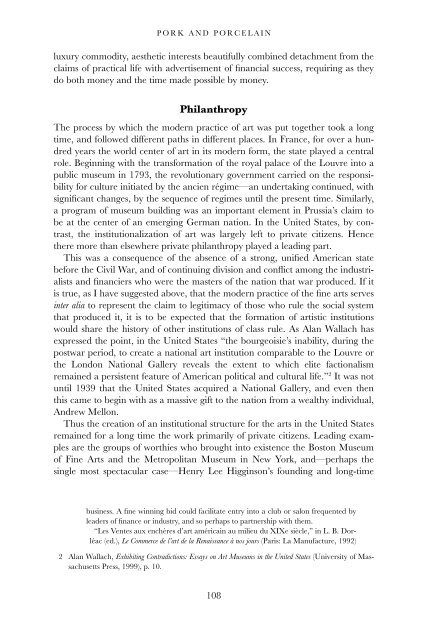Art in its Time: Theories and Practices of Modern Aesthetics
Art in its Time: Theories and Practices of Modern Aesthetics
Art in its Time: Theories and Practices of Modern Aesthetics
You also want an ePaper? Increase the reach of your titles
YUMPU automatically turns print PDFs into web optimized ePapers that Google loves.
PORK AND PORCELAIN<br />
luxury commodity, aesthetic <strong>in</strong>terests beautifully comb<strong>in</strong>ed detachment from the<br />
claims <strong>of</strong> practical life with advertisement <strong>of</strong> f<strong>in</strong>ancial success, requir<strong>in</strong>g as they<br />
do both money <strong>and</strong> the time made possible by money.<br />
Philanthropy<br />
The process by which the modern practice <strong>of</strong> art was put together took a long<br />
time, <strong>and</strong> followed different paths <strong>in</strong> different places. In France, for over a hundred<br />
years the world center <strong>of</strong> art <strong>in</strong> <strong>its</strong> modern form, the state played a central<br />
role. Beg<strong>in</strong>n<strong>in</strong>g with the transformation <strong>of</strong> the royal palace <strong>of</strong> the Louvre <strong>in</strong>to a<br />
public museum <strong>in</strong> 1793, the revolutionary government carried on the responsibility<br />
for culture <strong>in</strong>itiated by the ancien régime—an undertak<strong>in</strong>g cont<strong>in</strong>ued, with<br />
significant changes, by the sequence <strong>of</strong> regimes until the present time. Similarly,<br />
a program <strong>of</strong> museum build<strong>in</strong>g was an important element <strong>in</strong> Prussia’s claim to<br />
be at the center <strong>of</strong> an emerg<strong>in</strong>g German nation. In the United States, by contrast,<br />
the <strong>in</strong>stitutionalization <strong>of</strong> art was largely left to private citizens. Hence<br />
there more than elsewhere private philanthropy played a lead<strong>in</strong>g part.<br />
This was a consequence <strong>of</strong> the absence <strong>of</strong> a strong, unified American state<br />
before the Civil War, <strong>and</strong> <strong>of</strong> cont<strong>in</strong>u<strong>in</strong>g division <strong>and</strong> conflict among the <strong>in</strong>dustrialists<br />
<strong>and</strong> f<strong>in</strong>anciers who were the masters <strong>of</strong> the nation that war produced. If it<br />
is true, as I have suggested above, that the modern practice <strong>of</strong> the f<strong>in</strong>e arts serves<br />
<strong>in</strong>ter alia to represent the claim to legitimacy <strong>of</strong> those who rule the social system<br />
that produced it, it is to be expected that the formation <strong>of</strong> artistic <strong>in</strong>stitutions<br />
would share the history <strong>of</strong> other <strong>in</strong>stitutions <strong>of</strong> class rule. As Alan Wallach has<br />
expressed the po<strong>in</strong>t, <strong>in</strong> the United States “the bourgeoisie’s <strong>in</strong>ability, dur<strong>in</strong>g the<br />
postwar period, to create a national art <strong>in</strong>stitution comparable to the Louvre or<br />
the London National Gallery reveals the extent to which elite factionalism<br />
rema<strong>in</strong>ed a persistent feature <strong>of</strong> American political <strong>and</strong> cultural life.” 2 It was not<br />
until 1939 that the United States acquired a National Gallery, <strong>and</strong> even then<br />
this came to beg<strong>in</strong> with as a massive gift to the nation from a wealthy <strong>in</strong>dividual,<br />
Andrew Mellon.<br />
Thus the creation <strong>of</strong> an <strong>in</strong>stitutional structure for the arts <strong>in</strong> the United States<br />
rema<strong>in</strong>ed for a long time the work primarily <strong>of</strong> private citizens. Lead<strong>in</strong>g examples<br />
are the groups <strong>of</strong> worthies who brought <strong>in</strong>to existence the Boston Museum<br />
<strong>of</strong> F<strong>in</strong>e <strong>Art</strong>s <strong>and</strong> the Metropolitan Museum <strong>in</strong> New York, <strong>and</strong>—perhaps the<br />
s<strong>in</strong>gle most spectacular case—Henry Lee Higg<strong>in</strong>son’s found<strong>in</strong>g <strong>and</strong> long-time<br />
bus<strong>in</strong>ess. A f<strong>in</strong>e w<strong>in</strong>n<strong>in</strong>g bid could facilitate entry <strong>in</strong>to a club or salon frequented by<br />
leaders <strong>of</strong> f<strong>in</strong>ance or <strong>in</strong>dustry, <strong>and</strong> so perhaps to partnership with them.<br />
“Les Ventes aux enchères d’art américa<strong>in</strong> au milieu du XIXe siècle,” <strong>in</strong> L. B. Dorléac<br />
(ed.), Le Commerce de l’art de la Renaissance à nos jours (Paris: La Manufacture, 1992)<br />
2 Alan Wallach, Exhibit<strong>in</strong>g Contradictions: Essays on <strong>Art</strong> Museums <strong>in</strong> the United States (University <strong>of</strong> Massachusetts<br />
Press, 1999), p. 10.<br />
108
















